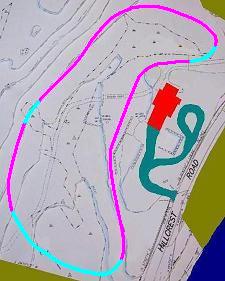

| Item | When Built | % Complete | Description |
| Deck Truss bridge | 10/03 - 6/04 | 100 | 20 feet long, crosses a small seasonal stream |
| Covered bridge | 0 | ? feet long, based on a local historic covered bridge | |
| Big Trestle | 8/08 - ongoing | 1 | 100 feet long, 8 feet tall |
| Low Trestle | 10/07-8/08 | 100 | 60 feet long, 2 feet tall, curved |
| Tunnel | 9/03 - 8/10 | 100 | 50 feet long, curved, cut-and-cover |
| Retaining wall | 10/04 | 100 | 30 feet long, routes track around a large tree |
| Ballast Bunker | 4/09 | 100 | Holds 3 yards of ballast, loads it into the hopper |
| Station | 2004 | 95 | Also known as the ground level of the kids' playhouse |

